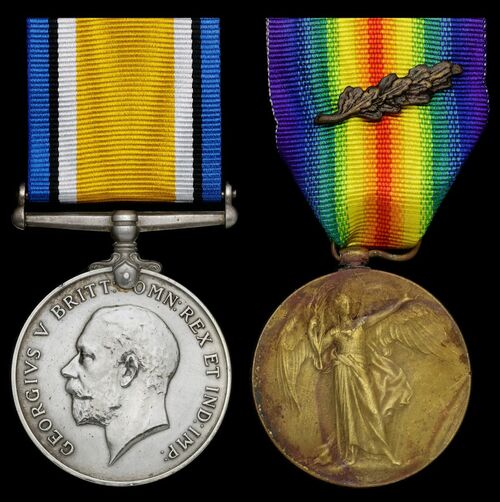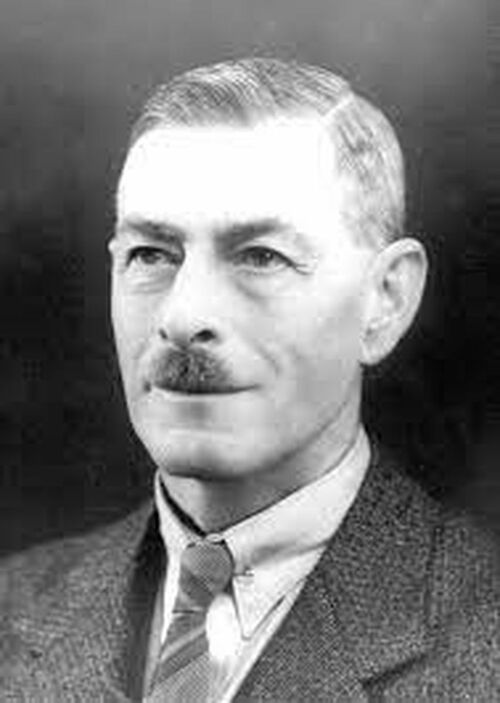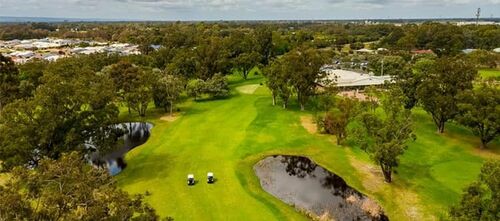Auction: 23111 - Orders, Decorations and Medals - e-Auction
Lot: 694
(x) The Great War campaign pair awarded to Captain E. G. Cohen, Royal Engineers, who was twice 'mentioned'
Perhaps his biggest contribution was as a prominent Australian architect, the E. G. Cohen Medal survives as his legacy to architecture
British War and Victory Medals, with M.I.D. oak leaves (Capt. E. G. Cohen), suspension on VM bent, worn, thus fine (2)
M.I.D. London Gazette 18 May 1917 & 7 July 1919.
Eustace Gresley Cohen was born at Kensington, London in 1881, the middle of three sons of Frederick Cohen, a stockbroker who died in 1887. Young Cohen was educated at Repton College and after completing his education began training in architecture with Thomas Lockwood and Sons at Chester. Later, he worked for Guy Dawber, past president of the Royal Institute of British Architects. In 1902, Cohen's mother, Elizabeth, died leaving the boys a substantial amount of money. At that time Cohen gave up architecture due to ill health and, in 1904, he and his older brother Gilbert, emigrated to Western Australia to take up farming. They bought "Beachlands" in Busselton and although it was not a financial success, Cohen recovered from his illness while there and returned to being an architect practicing in partnership with J. Herbert Eales at Perth.
Cohen had previously served as an officer in the Australian Intelligence Corps and made a valuable contribution to the military authorities of Western Australia by carrying out topographical surveys of the main roads of the State and reporting on the ability of bridges to carry artillery and heavy transport. While in Bunbury, he also participated in military exercises with the Light Horse Regiment.
On 22 June 1914, Cohen left for an extended holiday in England. During his stay in England, the Great War began. Cohen immediately reported to the War Office offering to help with coastal defence while he remained in England. However, in spite of his many years of training and considerable ability, the English forces initially would not accept him as he was an Australian. Instead, he had to wait until the Australian troops arrived but when they were diverted to Egypt, he decided he would return to Australia to enrol. He was on the mail boat about to depart England in January 1915, when he received the news that he had been accepted into the Inns of Court O.T.C.
Cohen was commissioned in to the Royal Engineers and served at the Battle of Loos. His brother Gilbert wrote of the dangers facing Eustace in a letter to Mr Harry Russell of Busselton:
'I expect you know poor old " Eusty " is in the Royal Engineers and has been having a very rough passage in France. He was home on short leave recently, and in excellent spirits. He has been in the thick of it at Loos; and was in the great battle there, and afterwards in the job of making good the advance, putting out wire entanglements in front of the advance trenches, etc. He is quite used to being potted at now, and has acquired the ' sapper nerve,' which enables a man to quietly do a bit of intricate barb wire fence, and at the same time afford the enemy a battle target that does not attempt to hit back.'
In a letter to Mr A. V. Parkes, Cohen explained one of the duties of the engineers was trying to work out ways to alleviate the intense discomfort suffered by the troops in the trenches.
In 1917, after serving 20 months in the trenches, Cohen took up the temporary position of Inspector of the Fourth Army Infantry School at Rouen where he trained engineers in trench work, the construction of gun emplacements and similar duties in the field.
Ever the golf enthusiast, Cohen likened the war to a golf match in a letter to the captain of the Bunbury Gold Club, Fred Roberts:
'As I write the Boche is putting over some long drives, but is using rather a heavy substitute for balls, which make a very nasty noise in coming to ground after the carry. He is, however, over driving and is a little bit on the slice side, so is not causing me much inconvenience only a little annoyance as it makes me jump.'
In the same letter, he also mentioned that, if he were to design any more golf courses after the war, he would be loath to use explosives.
By 1919, according to the Bunbury Herald, Cohen had been wounded twice and gassed three times in total without losing a day in the trenches. He was demobilized in 1919 and spent time with his brothers Gilbert and Hugh on the old family farm in North Wales before returning to Western Australia on the Indarra in 1920. Later that year, he delivered a lecture at the United Services League, St George's Terrace, Perth titled Field Engineering: The War and the Manual.
Cohen was actively involved with the Returned Services League and was a member of the state executive in Western Australia. Returning to Perth in 1920 and resuming architectural practice with Eales, Cohen was a major contributor in professional affairs, especially as president of the Royal Institute of Architects of Western Australia from 1924-25. He was the instigator of a prestigious bronze medal for students, which continued on after his death as the E.G. Cohen Medal.
Cohen married Maud Brazier on 26 April 1922; she was the eldest daughter of Lieutenant Colonel Noel Brazier who was the commanding officer of the 25th Light Horse and who commanded the 10th Light Horse, A.I.F. on their landing at Gallipoli. He remained a family friend of the Cohen brothers.
Colonel Brazier bred horses and Maud sometimes rode them in shows and she also "interested herself zealously" in the formation of a band for her father's Light Horse Regiment.
While Cohen and Maud were on honeymoon they met and spent time with D. H. Lawrence at Leithdale which was a popular guest house in the 1920's at Darlington in Western Australia. Lawrence and his wife, Frieda, stayed there from 6-18 May 1922.
Lawrence had this to say about Leithdale:
'We are here about 16 miles out of Perth - bush all around - marvellous air, marvellous sun and sky - strange, vast, empty country - hoary unending 'bush' with a pre-primaeval ghost in it - apples ripe and good, also pears. And we could have a nice little bungalow - but - but - BUT - Well, it's always an anti-climax of huts. - I just don't want to stay, that's all. It is so democratic, it feels to me infradig. In so free a land, it is humiliating to keep house and cook still another mutton chop.'
Extracted from a paper delivered by Sandra Jobson at the second D. H. Lawrence of Australia Society conference. She asserts that Victoria Callcott was based in part on Maude Cohen:
'As well, Maudie was convalescing from a broken leg caused by a bad fall down a lift shaft a few days before her wedding. Eustace Cohen was an architect and very interested in music. He was Welsh and had gone to school in England at Repton - the school where Pussy Jenkins' son was being educated.
Maudie was a member of the Brazier family. (Before I continue with the details of Maudie Cohen, I should interpolate that much of the information I gained about her came from Mary Brazier, nee Burt, great-great-granddaughter of Septimus Burt. And great-niece of Pussy Jenkins. Mary Brazier lives in Leake Ave, in exclusive Peppermint Grove. You can't get away from those family connections in Perth.)
Anyway, Mollie Skinner decided that the Cohens and the Lawrences would get on well, so she seated them together at one of the tables in the dining room. And indeed she was right, for Lawrence absorbed everything that Maudie, a young woman with warm brown eyes, told him about herself.
Her father, Major Noel Brazier, had been a surveyor in Victoria before moving to Western Australia where he established a dairy farm on the coast south of Perth. He had taken "the cream of the South West" to the First World War and had been shot in the eye at Gallipoli.
Maudie's mother, Edith Maude nee Hardwick, who was from Somerset in England, produced nine children, of whom Maudie was the eldest.
If these details are starting to ring bells, let me quote from Kangaroo: Somers asks Victoria Callcott:
"Was your home in Sydney'?"
She replies: "No, on the South Coast - dairy farming. No, my father was a surveyor, so was his father before him... Then he gave it up and started this farm down south."
And further down the page Victoria speaks about her mother: "She came from Somerset. Yes she died about five years ago. Then I was mother of the family. Yes, I am the eldest except Alfred."
Lawrence habitually took some characteristics from one person he met and tacked them on to the appearance or personality of another, to form a composite fictional character. Lawrence scholars have long tried to find out who in real life Lawrence had based part of the character of Victoria Callcott on. But they were thrown off the track by mention of the south coast dairy farm, naturally thinking it must have been geographically situated on the south coast of NSW not far from Thirroul. It wasn't until I went to Perth and discovered the details of Maudie's life from Mary Brazier, and Maudie's son Gresley and her youngest sister, Gwen Fitzharding, that I realised that of course there is also a south coast dairy farming area in Western Australia.
This is a photograph of an older Maudie Cohen which her son, Gresley, lent me when I visited him in Perth.
This solves one of the outstanding mysteries of Kangaroo. We now know on whom Lawrence based the outward guise of Victoria Callcott. However, there is little doubt that the guise was in fact a disguise for a real person who befriended Lawrence in Sydney.'
In the twenty-five-year portfolio of the Eales & Cohen partnership, which stretched from 1913-38, are the designs for many buildings in the southwest of Western Australia, some of which are listed on the State Register of Heritage Places.
Eustace Cohen was well known for his personal proficiency in golf and also for his contributions to golf architecture around the state of Western Australia. Cohen died in 1938 and Maud was 51 years old when she died in 1951.They had three children.
One academic legacy left by Cohen was the establishment of the E. G. Cohen Medal which is awarded to students (one for each Australian university offering architectural courses) who have achieved excellence in academic results and also demonstrated a spirit of unselfishness to their fellow students.
Further entitled to the 1914-15 Star.
Subject to 5% tax on Hammer Price in addition to 20% VAT on Buyer’s Premium.
Sold for
£200
Starting price
£100









